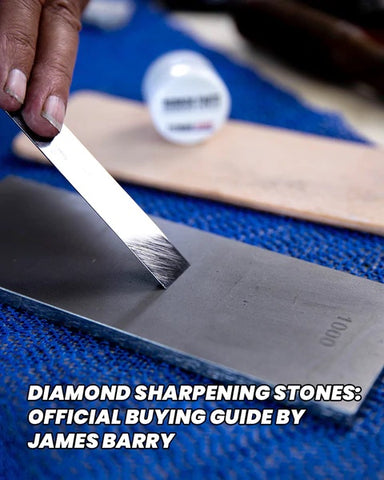How to Choose a Diamond Sharpening Stone
Like everything in life, not all things are created equal. And that certainly applies to diamond sharpening stones.
While there are many different types of diamond sharpening stones available to you, the biggest question is always "what determines the best quality?" You don't want to waste your hard-earned money on a diamond sharpening stone that'll only let you down.
In this guide, we'll share tips from world-renowned diamond sharpening expert James Barry on how to choose the best quality diamond sharpening stone for your needs and budget.

We met up with James Barry to discuss his products, watch him explain how his diamond stones are manufactured and how this compares to the competition below.
How to Understand the Grit of Diamond Sharpening Stone
Grit and micron sizes are almost impossible to equate or translate into traditional grit sizes of water & oil stones, they are totally different. The grit sizes quoted on James Barry diamond sharpening products are accurate to within the parameters of international grading standards which is +/- 11%.
Therefore a 25-micron product may consist of diamond particles varying from between 27.5 – 22.5.
But what sizes are we actually talking about?
Remember a human hair cut in half is approximately 50 microns. The actual cutting medium (micron size of diamond) is actually 1/3 of the quoted sizes.
Does My Diamond Sharpening Stone Need to be Broken in?
All the products have a breaking in period. There is an excess layer of diamond which needs to be removed before the surface is at its optimum designed sharpening abrasion.
But caution is required during this breaking in period.
Be careful when breaking in a coarse side (300 grit / 50 micron) to wipe down the tool thoroughly before moving to the fine side (1000 grit / 15 micron) to avoid cross-contamination and therefore taking a much coarser diamond onto a much finer side – it will scratch it!
Once the stone is worn in, you will not need to be quite so thorough as there is no longer a threat of cross-contamination.
How Are James Barry Diamond Sharpening Stones Manufactured?
It's the manufacturing process that determines whether the diamond sharpening stone you're about to purchase is of a good quality or not.
In construction, the precision ground substrate (+/- 0.005” flatness) is placed in a tank of nickel which is heated to a certain temperature. An electrical current is added which electroplates the nickel onto the surface. This includes the diamond particles, which, in turn, create the sharpening process.
The nickel is then grown around the particles so that they are buried 2/3 deep leaving a third of the diamond particles exposed (the designed abrasive cut).
The manufacturing process is similar to the construction and appearance of an iceberg.

The only way to quote the flatness of a diamond stone accurately is from the substrate only because of the variation of the diamond particles (+/- 11%) and because the new product does have to be broken in, as described above.
This is why the James Barry range of diamond products is regarded as one of the best available.
The Overall Flatness of the Stone is Vitally Important
The diamond is electroplated directly onto a precision ground substrate. Both sides are electroplated onto the same precision ground substrate giving the best possible flatness.
How does this compare with other diamond sharpening stones on the market?
The majority of other products are constructed by a “layer” system where a plate is electroplated or impregnated with diamond and then stuck onto some sort of base material, either plastic or steel.
Why? Because it's cheap and very easy to produce.
The production process for creating a James Barry diamond sharpening stone is the most complicated and complex but gives by far the best results. For the best quality, the diamond has to be electroplated directly onto the surface. It's as simple as that.
How to Get the Best Performance from Your Diamond Sharpening Stone
Ensure that you use the James Barry Original Formula lapping fluid, introduced into the Woodworking Industry by James Barry Sharpening Solutions over 25 years ago.

Lapping fluid is a synthetic based petroleum lubricant formulated to be used with diamond compounds. This superior lubricant, with its penetrating qualities and oil/water solubility, not only increases the cutting action but assures superior lubrication of every diamond particle throughout the honing process.
Following the success of Lapping fluid, it has been copied and companies have tried to reproduce the original formula. The only brand now selling the original product is James Barry Sharpening.

